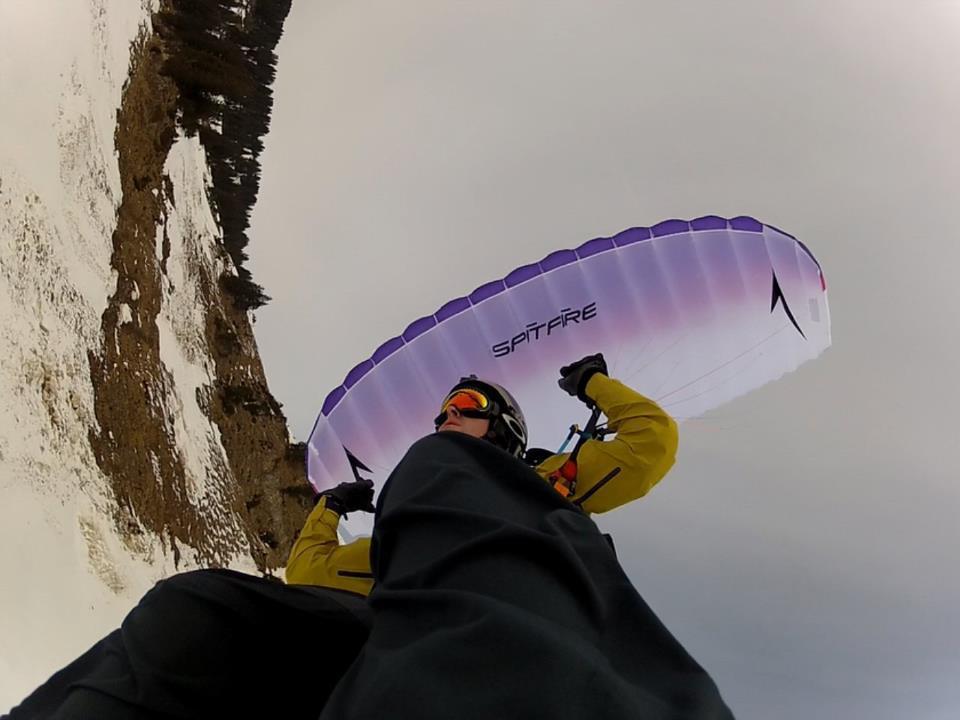Recommended Posts
BASE #1182
Muff #3573
PFI #52; UK WSI #13
According to Brian (and I think Scott Miller would agree)
the only thing that changes is our drift/ our perception to or dive.
so we are still losing the same amount of height, just in a different fashion...
Now perhaps psychologically we adjust to the change in sight picture and subconsciously change our turn completely thereby making us think that our turn is different, but if we threw down the same turn (adjusting for horizontal drift) in winds that we do in no wind or down wind our vertical descent is the same...
Dave
CSpenceFLY - I can't believe the number of people willing to bet their life on someone else doing the right thing.
Fast 0
QuoteQuoteIf you drop something in a train moving at 100mph, does it fall any faster than something dropped when u are standing on the ground? Likewise, in the air + canopy pilot system do you expect your turn to be any bigger whether the system is moving or not?
I dont see how that is a valid example here...QuoteTake the limits of your argument that wind affets the canopy. Lets say you are hooking it into a 1000 mph headwind. Does this mean that as soon as you start your turn you will pound into the ground?
How about hooking it into a tailwind of 1000 mph? Does this mean that if you dive with a tailwind that you will never reach the ground?
well... yes :) if you can get the canopy to open in the first place :)) (hey, what kind of answer did you expect with a question like that?) let's just say 20 mph. I think it will add speed to the way the canopy will dive in the first second or two of the turn.
There is no reason to use less wind. The canopy, and your body, doens't have any way of knowing how much wind it is in. You would have lots of track over the ground and actually landing would be difficult, but the canopy would open and if you were jumping over clouds you would have no idea what so ever that there was even that much wind. It doesn't have any effect.
x
<-
oooooooooooooooooooooooooooooooooooooooooooooooooooooo
<- <-
---------------------------------------------------------------------------
In the above picture there are 3 things. The ground represented by ---- , clouds represented by ooo, and a skydiver represented by the X.
The clouds and skydiver are both in the air. The wind you can call it. Both are moving to the left because the wind is blowing from the right to the left. The skydiver can't see the ground, he can only see clouds. It appears to him that they are standing still. He continues to fall over the exact same spot over the clouds all the way to deployment. Once deployed he can fly around more and now notices movement over the clouds (this would be the speed of the canopy) No matter how much wind there is blowing the skydiver and the clouds, you could do turns all day and not notice the difference. A turn in 1,000 mph steady unturbulent wind would feel exactly the same and appear exactly the same, and in fact, the way the air interacts with the canopy would be exactly the same.
As soon as you change the reference to the ground, which is NOT affected by wind and is always a constant stationary object, your frame of reference changes and you will feel like something different is happening. I say feel because it only feels that way. The canopy is still in the same air and acting exactly the same, your mind is just making its comparasin to something else.
On days with no wind, the ground acts more similar to the clouds in terms of acting as a frame of reference.
Does this help?
Where troubles melt like lemon drops Away above the chimney tops That's where you'll find me.
Swooping is taking one last poke at the bear before escaping it's cave - davelepka
the relative wind to the canopy is always coming from the nose side...so the whole if you turn into the wind the wind makes your canopy dive faster is not true...
not sure if anyone stated that in here but I thought I would throw in that 17 and 1/2 cent piece
Dave
CSpenceFLY - I can't believe the number of people willing to bet their life on someone else doing the right thing.
Fast 0
Quoteoh yeah and the wind to the top skin thing is a fallacy
the relative wind to the canopy is always coming from the nose side...so the whole if you turn into the wind the wind makes your canopy dive faster is not true...
not sure if anyone stated that in here but I thought I would throw in that 17 and 1/2 cent piece
Dave
The only way that wind has an effect on canopies is in turbulence. In a turn if your topskin is exposed to the direction the wind is coming from and a wind gust occurs (a dramatic change in wind speed over a short period of time) it can cause your topskin to temporarily collapse because there is period of time that it takes for your body (which, as the weight in the system that keeps everything taut) to adjust to that gust, and because of the greater mass of your body it takes longer than the topskin. So the skin goes slack for a few moments. That can lead to other problems. Thats one of the reasons swooping in really turbulent/gusty air can be a bit more scary.
Or at least that is how I have understood it.
Where troubles melt like lemon drops Away above the chimney tops That's where you'll find me.
Swooping is taking one last poke at the bear before escaping it's cave - davelepka
frost 1
QuoteWell, the three of us agree...
LOL funny. I guess I am wrong by default then. But has it never happened before where a well respected and widely accepted theory has been proven wrong?
In case it wasnt clear - i am simply raising a discussion here, not trying to defend or disprove anyone's position. I have considered all the points made here, and they make sense, no doubt. I have taken this point as a given when i first read Brian Germain's book and listened to Scott Miller's courses. Whenever a discussion was presented - i'd stick to this point of view. But then i started thinking and questioning it. For the last year or so i have not been a fan of these points of view. I may be wrong - and that's ok. I am not an expert, I have no background in aerodynamics, but even experts and well respected scientists make mistakes. Questioning the experts and thinking about stuff and not taking a theory as an axiom is a way to advance yourself and possibly the discipline.
Gotta go... plaything needs to spank me
Feel the hate...
Photos here
QuoteThe only way that wind has an effect on canopies is in turbulence. In a turn if your topskin is exposed to the direction the wind is coming from and a wind gust occurs (a dramatic change in wind speed over a short period of time) it can cause your topskin to temporarily collapse because there is period of time that it takes for your body (which, as the weight in the system that keeps everything taut) to adjust to that gust
That does not happen. It would happen if we were standing on something solid, but we're not. The only thing a gust does is change the speed that we're moving in the "river of air." The canopy is still be pressurized from the air coming in the nose, not due to forces on the topskin created by wind that the jumper and canopy are moving with.
You are simply not believing the overall basic concept that I laid out in the other thread. If you can believe that simple and proven true concept then you'll see that a gust will not do what you're trying to say it does.
marks 0
QuoteI strongly believe that wind affects the canopy flight relative to the ground below. From the basic glide to advanced turns, the canopy is affected by winds. I agree with the statement that wind does not affect how the canopy flies, since nothing aerodynamically changes about the wing (unless it distorts or collapses). But it does change how it flies in relationship to the ground.
it does change the relationship between the ground and air.
QuoteLet's use the example i quoted above, which i think is a very interesting one. Seems to me it has some elements of theory of relativity. The person in the train is walking at the same speed, but is covering different distance in relationship to the absolute object (earth). Same can be applied to the canopy in flight. Your canopy will still have the same speed, but you will fly different in realtionship to the ground. If the wind is 10 mph, you're flying forward at 30 mph, your speed relative to the ground will be 20 mph. That's basic stuff that even students know, right?
your only problem in understanding this whole thing is that you keep referencing the ground.. that is where your perception comes from.
take the ground COMPLETLY out of the equation, and then rethink it. make sure the ground, or any object not subject to the wind itself is eliminated from your thoughts.
QuoteSo is it just my perception that the canopy flies different in turns (relative to the ground) when there are high winds?
yes, take the ground out of consideration and you may see what i mean.
Quote
If it's affected by wind in full flight (again, relative to the ground), why wont it be affected in a turn?
once again, forget the ground. the parachute knows nothing of it. only your eyes do.
QuoteWhen you turn your canopy you are exposing more of your wing to the wind, right?
no, it is all relative.
QuoteIn addition to blowing you off course, the wind makes air move at faster (or slower) speeds over that wing, creating more (or less) lift.
it only blows you off course "relative" to the ground. again, take the ground out of consideration and your flying straight "relative" to the wind.
think about when your flying at altitude straigh ahead, and you have a 50 mph cross wind. is the wind going to feel like it is coming from your side? no it will be coming from straight ahead.
QuoteMakes sense? So how would the wind not affect the flight RELATIVE to the ground?
it does effect it relative to the ground. but it makes no difference to the wing. none whatsoever. it is flying in its column of air. and turn speed and rate and altitude are all the same...
your noodle spun yet?
QuoteIn conclusion, I am willing to bet a jump that if you turn at the same speed from the same altitude in high winds you will fly into the ground :)
I will take you up on that bet.
alot of this is very difficult to understand, even though it is so easy. because your brain is telling you one thing from its experience, but in this case, your experience, and your brain are wrong. but trust me, once you get it, you will completely understand how simple it is..
open your mind to what i have written, and really THINK about it. you will get it..
marks 0
QuoteI remember overhearing the opposite at a dropzone not too long ago: people were saying that you have to hook it lower in higher winds because your recovery arc is shorter not longer. WTF.
it is a very common misconception.
In a stable airmass, with you drifting with it, it doesn't matter what direction you are facing (balloon example above).
However, thermic gusts, for instance, will cause an acceleration on the canopy faster than the person (relate this back to throwing a piece of tissue from a pylon - it gets a more horizontal separation as it accelerates to the airmass' velocity faster than the BASE jumper will). Given a little time, the pilot of the canopy will catch up, but not immediately. All of this is experienced by "bounciness" on landing approaches when it's thermic.
You are right, however, to assert that in a steady state the absolute wind velocity does not make any difference!
Regarding initiation altitudes, I wonder if it has something to do with level of control input required? For example, in nil wind, you will need a longer toggle stroke in order to flare than in high wind, as you seek to set the ground speed to zero which is merely to have enough speed in an opposing direction to the wind, rather than stop the canopy flying altogether. As a result, maybe the swooper is fooled into thinking he's too high as the amount of input required was less? No more speed was induced in the turn; but instead of going from say 50mph to 0mph, the canopy is going from 50mph to 20mph (where 0 and 20mph are the wind speeds respectively)
BASE #1182
Muff #3573
PFI #52; UK WSI #13
marks 0
QuoteHowever, thermic gusts,
if you want to talk about gust's, start another thread you will confuse people.
we are talking about wind. wind in and of itself. not thermals not gusts. not rotors. just solid wind.





The issues is that, wind only has an effect on where you are on the X Y coordinate plane. Your Z plane (altitude) is not affected by the wind unless there are up and down drafts.
No matter what the wind how the canopy flies in the turn will always be the same. Your position over the ground will be drastically affected by the wind however. What exactly you have to do in order to compensate and hit the gates depends on how much wind there is. If you don't care where you come out of the turn over the ground you don't have to do anything different. It will however look pretty damn scary because your frame of reference (the ground) isn't moving like it does on days w/o wind.
The reason people have the perception that wind affects how the canopy turns is because of how we "know" what the canopy is doing. We use the ground as a reference. Therefor if our reference object appears to be doing something different when there is more wind, we in turn assume that the canopy is performing different. That just isn't the case. The baloon is the best example. If you swoop a balloon, it will ALWAYS look the same as you execute the turn. You would never have to compensate for wind to hit a balooon.
Where troubles melt like lemon drops Away above the chimney tops That's where you'll find me.
Swooping is taking one last poke at the bear before escaping it's cave - davelepka
Share this post
Link to post
Share on other sites